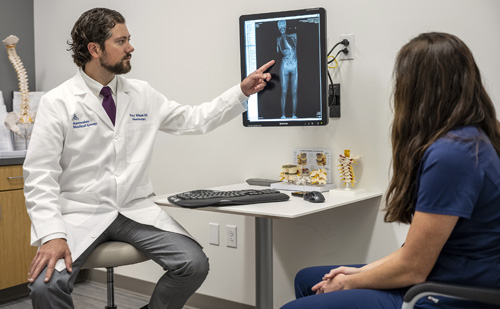Spinal Tumor

Overview
Spinal cord tumors are abnormal growths of tissue found inside the bony spinal column, which is one of the primary components of the central nervous system. Benign tumors are noncancerous, and malignant tumors are cancerous.
The spinal cord is housed within rigid, bony quarters (i.e., the skull and spinal column), so any abnormal growth, whether benign or malignant, can place pressure on sensitive tissues and impair function. Tumors that originate in the brain or spinal cord are called primary tumors.
Spinal tumors are classified by the spinal region where they appear, such as lumbar (low back); thoracic (upper back) and cervical (neck). How they appear in the spinal area is also labeled as:
- Intradural-extramedullary tumors: These tumor are within the thin dura layer of the spinal cord but outside the spinal cord. Tumors may labeled as a meningiomas, schwannomas, neurofibromas, or at the spinal cord base. Ependymomas that appear at the end of the spinal cord can be large, and can be difficult to remove.
- Intramedullary tumors: These tumors grow inside the spinal cord. Astrocytomas and ependymomas are the two most common types. Astrocytomas are more common in the thoracic region followed by the cervical. Ependymomas are most common in the filum (bottom region of the spinal cord), followed by the cervical region.
- Extradural tumors: These tumors are located outside the dura, and can be linked to metastatic cancer that has spread from other parts of the body.
Causes
Most primary tumors are caused by out-of-control growth among cells that surround and support neurons. In a small number of individuals, primary tumors may result from specific genetic disease (e.g., neurofibromatosis, tuberous sclerosis) or from exposure to radiation or cancer-causing chemicals. The cause of most primary tumors is unknown.
Symptoms
The most frequent symptom of benign and malignant spinal tumors is back pain. However, this type of back pain doesn’t not start with an injury, stress or physical activity. The type of back pain may worsen with activity or when lying down. The back pain may also worsen over time and spread to the hips and legs, which is a sign that the tumor is pressing on nerve roots. Spinal cord tumor symptoms include back pain, numbness in a leg, muscle weakness, incontinence, loss of bowel and bladder control and muscle spasms. Other symptoms may include changing sensitivity to heat or cold, and difficulty walking.
Treatment
The goal in the treatment of spinal cord tumors is to minimize nerve damage related to compression of the spinal cord. The three most commonly used treatment options are surgery, radiation and chemotherapy to kill any remaining cancer cells. Steroids may also be used to reduce swelling.
Spine surgeons use an array of diagnostic tests including MRI and CT to visualze the tumor and determine treatment options including surgical removal of the tumor. Lab tests can include an EEG and a spinal tap. A biopsy may also be performed, to remove a piece of the tumor tissue to diagnose the type of tumor. The tumor may be classified as benign or malignant and graded to enable the surgeon or oncologist to develop a prognosis or outcome for the patient.
